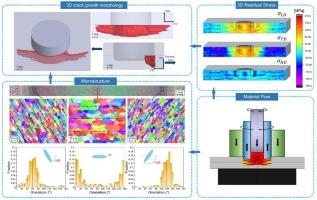Three-dimensional mapping of residual stresses and crack propagation in refill friction stir spot welded aluminium samples via synchrotron X-ray diffraction and X-ray micro-computed tomography
IF 6.8
2区 材料科学
Q1 ENGINEERING, MECHANICAL
引用次数: 0
Abstract
Refill Friction Stir Spot Welding (refill FSSW) shows strong potential to replace riveting in the aerospace industry. However, the complex deformation and thermal effects associated with this process lead to residual stresses that may influence the fatigue life of the joint. This study reveals for the first time the non-uniform residual stresses across the thickness of a refill FSSW aluminium joint using synchrotron X-ray radiation in combination with a conical slit cell. Clear differences can be observed in the stresses between the region subjected to plasticisation and that affected solely by heat input. A fatigue testing campaign on the aluminium joints demonstrated their high reproducibility and robustness. X-ray micro-computed tomography enabled the three-dimensional visualisation of fatigue crack nucleation and propagation morphology, the latter correlated with the tensile residual stresses in the weld area. The results can contribute to the development of more accurate fatigue life prediction models and improve the overall reliability of refill FSSW aluminium joints in engineering applications.

利用同步加速器x射线衍射和x射线微计算机断层扫描技术对铝搅拌摩擦点焊试样的残余应力和裂纹扩展进行三维映射
填充搅拌摩擦点焊(填充FSSW)显示出强大的潜力,以取代铆接在航空航天工业。然而,与此过程相关的复杂变形和热效应会产生残余应力,从而影响接头的疲劳寿命。本研究首次利用同步x射线辐射结合锥形狭缝单元揭示了填充FSSW铝接头厚度上的非均匀残余应力。在受塑化影响的区域和仅受热输入影响的区域之间的应力可以观察到明显的差异。对铝接头的疲劳测试表明其具有高重复性和坚固性。x射线微计算机断层扫描能够三维显示疲劳裂纹的形核和扩展形态,后者与焊缝区域的拉伸残余应力相关。研究结果有助于建立更精确的疲劳寿命预测模型,提高工程应用中填充FSSW铝接头的整体可靠性。
本文章由计算机程序翻译,如有差异,请以英文原文为准。
求助全文
约1分钟内获得全文
求助全文
来源期刊

International Journal of Fatigue
工程技术-材料科学:综合
CiteScore
10.70
自引率
21.70%
发文量
619
审稿时长
58 days
期刊介绍:
Typical subjects discussed in International Journal of Fatigue address:
Novel fatigue testing and characterization methods (new kinds of fatigue tests, critical evaluation of existing methods, in situ measurement of fatigue degradation, non-contact field measurements)
Multiaxial fatigue and complex loading effects of materials and structures, exploring state-of-the-art concepts in degradation under cyclic loading
Fatigue in the very high cycle regime, including failure mode transitions from surface to subsurface, effects of surface treatment, processing, and loading conditions
Modeling (including degradation processes and related driving forces, multiscale/multi-resolution methods, computational hierarchical and concurrent methods for coupled component and material responses, novel methods for notch root analysis, fracture mechanics, damage mechanics, crack growth kinetics, life prediction and durability, and prediction of stochastic fatigue behavior reflecting microstructure and service conditions)
Models for early stages of fatigue crack formation and growth that explicitly consider microstructure and relevant materials science aspects
Understanding the influence or manufacturing and processing route on fatigue degradation, and embedding this understanding in more predictive schemes for mitigation and design against fatigue
Prognosis and damage state awareness (including sensors, monitoring, methodology, interactive control, accelerated methods, data interpretation)
Applications of technologies associated with fatigue and their implications for structural integrity and reliability. This includes issues related to design, operation and maintenance, i.e., life cycle engineering
Smart materials and structures that can sense and mitigate fatigue degradation
Fatigue of devices and structures at small scales, including effects of process route and surfaces/interfaces.
 求助内容:
求助内容: 应助结果提醒方式:
应助结果提醒方式:


